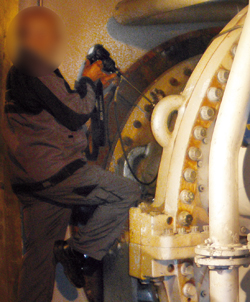From approximately 10.3 million tons of crude oil per year, Bayernoil produces quality products including liquefied gases, fuels, petrol, jet fuel, diesel, heating oil and bitumen. The capacity of the storage tanks is more than 1.8 million cubic metres. Around 725 employees work in the two company sites in Vohburg and Neustadt-on-Danube, some of them working in shifts to ensure that products will be available to company partners according to their requirements. The two operating sites work like a refinery at a single location. To make sure that this functions smoothly, they are connected by 11 pipelines.
"Refining" means purifying or enhancing. Obtaining the full range of mineral oil products from crude oil requires a multi-stage process. It is split into its various components in different plants and further processed into fractions. The complex production processes run around the clock and are automatically controlled and monitored by trained employees in two control rooms. All finished products are subject to stringent internal and external quality control as specified by DIN and ISO standards, EC directives and the standards of the shareholders. The safety of the refinery takes first priority. In March 2013, several plants in Vohburg were subjected to obligatory TÜV audits for the first time. A total of some 4,500 different fittings and devices were checked or repaired. Overhauling and cleaning work took place in parallel. During the shutdown period, about 1,500 additional employees from partner companies were working on the refinery sites.

Operating the plants, in which every litre of crude oil has to be heated to over 200°C, requires an enormous amount of power. This is partly produced directly by Bayernoil. At the Neustadt location, part of the power supply is ensured by a large gas turbine. It has been operating for more than 20 years.
The gas turbine is lubricated by 6,500 litres of a semi-synthetic ISO VG 32 gas turbine oil. Every six years, it undergoes a major inspection. An oil change is needed about every three years. To allow this to be scheduled well in advance, the oil is tested every six months at OELCHECK in a trend analysis, since the gas turbine is the main source of power for the refinery. If it were damaged or failed unexpectedly, the resulting cost and effort would be considerable.
Turbine oils, especially in gas turbines, must be monitored carefully. OELCHECK offers nine different analysis kits for testing turbine oil. Data for the turbine-specific parameters is provided on customised sample information sheets. Turbine oil sets also include larger sample bottles (up to 1 litre), because certain test procedures, such as water and air separation characteristics, or foam release characteristics, require a fairly large amount of oil. For many years, the oil in the gas turbine at Neustadt has been tested twice a year using the OELCHECK T6 analysis kit. The remaining service life of the oil can be estimated from the trend data if the operating conditions do not change significantly. In addition to degradation of antioxidants in the oil, additional contaminants are detected at an early stage. This is important because all changes can adversely affect oil ageing, air release characteristics, wear protection and foaming characteristics.
related links
